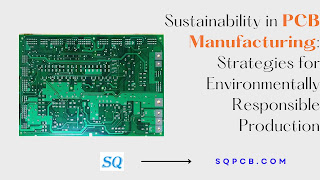Sustainability in PCB Manufacturing: Strategies for Environmentally Responsible Production
In today's rapidly evolving industrial landscape, sustainability has become
a paramount concern for businesses across various sectors. The electronics
manufacturing industry, in particular, faces significant challenges in reducing
its environmental footprint due to the complex nature of its supply chain and
the materials involved in production. Within this sector, Printed Circuit Board (PCB) manufacturing represents a critical
area where sustainable practices can make a substantial impact. This article
explores the importance of sustainability in PCB manufacturing and outlines
strategies for achieving environmentally responsible production.
The Environmental Impact of PCB Manufacturing:
PCB manufacturing processes involve the use of materials such as copper,
fiberglass, and various chemicals, including solder masks and surface finishes.
These materials can have significant environmental implications at various
stages of the PCB lifecycle, including raw material extraction, manufacturing,
use, and disposal.
1. Resource
Depletion: The extraction of raw materials, such as copper and
fiberglass, can lead to habitat destruction, soil erosion, and water pollution.
Moreover, the manufacturing process itself consumes substantial amounts of
energy and water, contributing to greenhouse gas emissions and resource
depletion.
2. Chemical
Pollution: Chemicals used in PCB manufacturing, such as etchants,
soldering fluxes, and cleaning solvents, can be hazardous to human health and
the environment if not managed properly. Improper disposal of these chemicals
can lead to soil and water contamination, posing risks to ecosystems and local
communities.
3. Waste
Generation: PCB manufacturing generates significant waste streams,
including leftover copper, solder, and manufacturing by-products. Improper
handling of waste can result in landfill pollution and contribute to the
depletion of natural resources.
Strategies for Environmentally Responsible PCB Manufacturing:
1. Material
Selection: Choosing environmentally friendly materials is a crucial
step towards sustainable PCB manufacturing. Opting for recycled or renewable
materials, as well as alternatives with lower environmental impacts, can help
reduce the ecological footprint of PCB production. Additionally, selecting
materials that are free from hazardous substances, such as lead and brominated
flame retardants, can minimize the environmental and health risks associated with
PCBs.
2. Energy
Efficiency: Implementing energy-efficient practices and technologies
can significantly reduce the carbon footprint of PCB manufacturing. This
includes optimizing manufacturing processes, upgrading equipment to
energy-efficient models, and utilizing renewable energy sources such as solar
and wind power. By reducing energy consumption, manufacturers can lower
greenhouse gas emissions and operating costs simultaneously.
3. Waste
Reduction and Recycling: Implementing waste reduction and recycling programs
is essential for minimizing the environmental impact of PCB manufacturing. This
includes optimizing production processes to minimize material waste,
segregating and recycling scrap materials, and exploring innovative recycling
technologies for reclaiming valuable resources from end-of-life PCBs.
Additionally, implementing closed-loop manufacturing systems can help reduce
reliance on virgin materials and promote circular economy principles.
4. Emissions
Control and Pollution Prevention: Implementing stringent emissions
control measures and pollution prevention techniques is essential for
mitigating the environmental impact of PCB manufacturing. This includes
investing in pollution control equipment, such as scrubbers and filters, to
capture and treat air and water emissions. Furthermore, implementing best
practices for chemical management, such as proper handling, storage, and
disposal of hazardous chemicals, can help prevent pollution and protect human
health and the environment.
5. Certifications
and Standards Compliance: Obtaining certifications such as ISO 14001
(Environmental Management Systems) and complying with industry standards such
as Restriction of Hazardous Substances (RoHS) and Waste Electrical and
Electronic Equipment (WEEE) directives are essential for demonstrating
commitment to environmental responsibility. Compliance with these standards not
only helps mitigate regulatory risks but also enhances the reputation and
marketability of environmentally conscious PCB manufacturers.
Sustainability is no longer a choice but a necessity for the PCB manufacturing industry. By adopting environmentally
responsible practices, such as material selection, energy efficiency, waste
reduction, emissions control, and standards compliance, PCB manufacturers can
minimize their environmental footprint while enhancing operational efficiency
and competitiveness. Embracing sustainability not only benefits the environment
and society but also ensures long-term viability and resilience in an
increasingly resource-constrained world. As the electronics industry continues
to evolve, sustainability will remain a fundamental guiding principle for PCB manufacturers
committed to creating a greener and more sustainable future.


Comments
Post a Comment